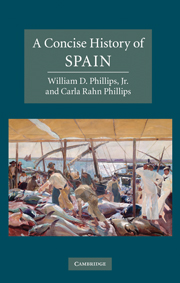Book contents
- Frontmatter
- Contents
- List of illustrations
- List of maps
- Preface
- 1 The land and its early inhabitants
- 2 Ancient legacies
- 3 Diversity in medieval Spain
- 4 The rise of Spain to international prominence
- 5 Spain as the first global empire
- 6 Toward modernity: from the Napoleonic invasion to Alfonso XIII
- 7 The struggle for the Spanish soul: Republic, civil war, and dictatorship
- 8 New Spain, new Spaniards: European, democratic, and multi-cultural
- Chronology and rulers
- Guide to further information
- Index
- Titles in the series
2 - Ancient legacies
Published online by Cambridge University Press: 05 August 2012
- Frontmatter
- Contents
- List of illustrations
- List of maps
- Preface
- 1 The land and its early inhabitants
- 2 Ancient legacies
- 3 Diversity in medieval Spain
- 4 The rise of Spain to international prominence
- 5 Spain as the first global empire
- 6 Toward modernity: from the Napoleonic invasion to Alfonso XIII
- 7 The struggle for the Spanish soul: Republic, civil war, and dictatorship
- 8 New Spain, new Spaniards: European, democratic, and multi-cultural
- Chronology and rulers
- Guide to further information
- Index
- Titles in the series
Summary
A formative period for Spanish history began with the Roman conquest at the end of the third century bce. Roman political control thereafter expanded over most of the peninsula and lasted though the fourth century ce, as Iberia became one of the most Romanized portions of the empire. Fundamental components of Iberian life were set in place and continued to influence later developments long after the Roman Empire ended. Roman innovations and foundations underlay many medieval and modern developments in Spain and remain strong and apparent in Spain today in such areas as language, law, and religion.
Initially, the process of Romanization in Iberia proceeded slowly, as the Romans followed the pattern that their ancestors had set in taking over the Italian Peninsula, making treaties with groups who agreed to join them voluntarily and conquering those who chose to resist. Nonetheless, it took about 200 years for the Romans to establish full control in Iberia, whereas they conquered Gaul in a decade. The difficult terrain and the traditions of local rule in Iberia made the Roman conquest extraordinarily difficult, and there was scarcely a year in two centuries that did not see fighting in one or more regions.
Soon after the conquest, the Romans divided the area into two parts: Hispania Citerior and Hispania Ulterior (Closer and Farther Spain, respectively). All they really controlled by the end of the Punic Wars was a band along the Mediterranean coast and beyond Gibraltar as far as Cádiz.
- Type
- Chapter
- Information
- A Concise History of Spain , pp. 21 - 46Publisher: Cambridge University PressPrint publication year: 2010

